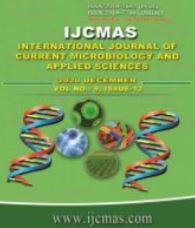


 National Academy of Agricultural Sciences (NAAS)
National Academy of Agricultural Sciences (NAAS)

|
PRINT ISSN : 2319-7692
Online ISSN : 2319-7706 Issues : 12 per year Publisher : Excellent Publishers Email : editorijcmas@gmail.com / submit@ijcmas.com Editor-in-chief: Dr.M.Prakash Index Copernicus ICV 2018: 95.39 NAAS RATING 2020: 5.38 |
India is renowned throughout the world as “spice bowl” due to production and export of spices. Ginger is an economically important cash crop grown for its aromatic underground rhizomes. Rhizome rot or soft rot is the most destructive diseases of ginger worldwide. The pathogen associated with rhizome rot complex disease of ginger in Karnataka includes Pythium aphanidermatum (causes soft rot), Ralstonia solanacearum (bacterial wilt), Fusarium solani (yellows), Sclerotium rolfsii (Sclerotium rot) and Meloidogyne arenaria (root knot). In the interaction study, R. solanacearum took 16 days to express the symptoms in individual inoculation with highest rot incidence (55.56 %). In case of P. aphanidermatum, the symptoms were expressed within 19 days after inoculation with 43.55 per cent disease incidence. The symptoms were seen within 10 DAI with all pathogens (P + F + R + S + M). In sequential inoculation of M. arenaria followed by R. solanacearum after 15 days, recorded maximum incidence of disease (91.67 %). The disease was expressed in 21 DAI of pathogens.
 |
 |
 |
 |
 |